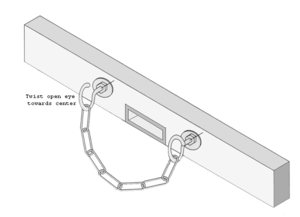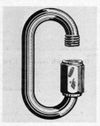IBLS Safety Chain Standards
(Redirected from IBLS Coupler and Safety Chain Standards)
Jump to navigation
Jump to search
Coupler, Chain and Hook Arrangement
| Scale | Gauge | Coupler/Chain Hook Height (CH) | Chain Offset (CO) | Hook Size | Link Size | Chain Length |
| 1/2" | 2-1/2" | 1-15/16 | ||||
| 3/4" | 3-1/2" | 2-1/4 | ||||
| 1" | 4-3/4" | 2-7/8" +/- 1/4" | 1-1/4" | 0.11" | 3-1/2" +/- 1/2" | |
| 1" | 5" | 3-1/4" +/- 1/4" | 1-1/4" | 0.11" | 3-1/2" +/- 1/2" | |
| 1-1/2" | 7-1/4" | 4-7/16" +0" -3/16" | 2-1/2" +/- 1/4" | 1/4" | 1/8"x1" welded | 7" +/- 1" |
| 1-1/2" | 7-1/2" | 4-7/16" +0" -3/16" | 2-1/2" +/- 1/4" | 1/4" | 1/8"x1" welded | 7" +/- 1" |
| 1.6" | 7-1/2" | 4-7/16" +0 -3/16" | 2-1/2" +/- 1/4" | 1/4" | 1/8"x1" welded | 7" +/- 1" |
| 2.5" | 7-1/4"+ | 5.4" | ||||
| 3" | 12" | 7.5" |
- Explanation
- Coupler height is measured from the top of rail to the horizontal center-line of the coupler
- Right hook is a captive hook
- Left hook is an open hook
- Hook Size refers to the diameter of the hook shank
- Chains must pass over hooks
- When chain is not in use it should be hooked onto the open hook of the same car
- 2013/03/20 - Added 1" length to chains for 1-1/2" and 1.6" scale to provide enough length when not in use
- If cars are close due to short coupler shanks the 2nd or 3rd link from the end of the chain can be hooked onto the open hook of the other car.
Tidbits From Chaski
From http://www.chaski.com/homemachinist
Carl B "ccvstmr"
- ILS standard calls for two (2) 1/4" hooks at 2.5" distance from the centerline of the car. I set the hooks at 3" because I don't like to "crowd" the coupler. Eyebolts with 1/4x20 thread and various length shanks can be purchased at most hardware stores. The left hook is twisted open while the right hook is opened...the chain inserted...and the hook closed to make the chain captive. I would suggest putting hooks in a vise and using a crescent wrench to twist the hook open as much as needed to slip the chain on...and then close the eye bolt. Do not try to "unwind" the the hook loop and then squeeze it closed.
- Chains are 6" +/- 1". Chain material is 1/8" x 1" welded link...although 3/16" x 1" link would also do. The chain must fit over the chain hooks. Wire-wrap chain is not acceptable either.
- One point that is often overlooked...is the method in which the the chain hooks are attached to the loco/car body. A screw-in eye-bolt hook is not acceptable, nor is a hook attached to an end-sill that is nailed to the end of the car. In other words, the hook attachment to the car body must be strong enough to withstand the forces transmitted through the chain(s) during a derailment. It is better to destroy the hook (straighten it out) instead of destroying your rolling stock or let your cars get away and be stopped by the next train that follows.
- If anchoring hook in metal...drill a #7 hole and tap for a 1/4-20 thread. Use a nut on both sides to "lock" the eye bolt in place. If anchoring hook in wood...drill a 1/4" hole and again, use a nut on the face and back to hold in place. Do not use "lag" type eye bolts for wood. If you have a wood end sill...back it up with a well anchored piece of steel angle. If the equipment uncouples, you don't want the chains to yank the wooden sill off. btw...flange nuts look decent on the face...Nylok nuts on the back.
- Another item to watch for...always make sure that safety chains are hooked at both ends...even if it's the last car of the train. A dragging chain will easily catch a turnout frog and/or heel block if you're not careful. The result...time to replace the chain hooks. Hope this helps.
- Coupler height...most clubs have coupler height specs. Some follow IBLS, others are not far away. Usually the center of the coupler is set 4-1/4" to 4-7/16" over the rail head. Of course, as long as "out of spec" equipment is not coupled or run with "in spec" equipment, there's no problem. However, if the couplers have excess vertical motion, this is where a problem can start.
ehulshiz
- At Train Mountain they do it much as described above, but they use closed eyes and threaded chain "repair links" (you know the ones).
10 Wheeler Rob
- Purpose of safety chains is not for derailments, but to keep rolling stock and a cargo of pasengers from rolling away in the event of a coupler failure or disconect. This is because very few cars have self energized brakes in the hobby.
- Depending on the design of the underside of the rolling stock, you could follow something along the line of what Lee Wright does. Lee either welds a chain tab on the underside of the car or drills a hole in the flange of his centersill. "D" rings are used to connect the chain to the tab or centersill flange. The chain is 1/8" links about 1" long. While this may not be exactly on the centerline of the car, it's still pretty darn close.
- One possible drawback (there's always a tradeoff), you have to get down on the ground to find the hole or D ring to connect the chains. The photo shows two chains, but you could probably get away with one.
Video
References
- Illinois Live Steamers 1-1/2" Scale Standards
- IBLS Wheel Standards - Finger Lakes Live Steamers
- IBLS Wheel Standards - Ridge Live Steamers
- Safety Chains - Carl B. "ccvstmr" - Chaski
- 1" Scale Safety Chain Data, Carl B. "ccvstmr", Chaski
- Safety Chains - Letters to the Editor - DiscoverLiveSteam.com
- Code of Practice, Version 7 April 2012, Australian Association of Live Steamers
- "Safety Chains", Bruce G. Saylor, Live Steam Magazine, Sept/Oct 1995
- "Safety Chains?", Bob Hall, Live Steam Magazine, Mar/Apr 1997
- "Safety Chains or Drawbars Required: Counterpoint", Quentin Breen, Live Steam Magazine, Jul/Aug 1997
- "Runaway Train Car!!" (Video), Chattanooga Society of Engineers
- #308 For The MSRy - Safety Chains for a Caboose
- NMRA S-2 Coupler Standards (coupler heights only)
- "Coupling Couplers", Harry Bean, LOCO News, Volume 18, No. 1, January-February 2005
- "The Science of Railway Cars", 1909 edition, Google.com
- "Coupler height, 2-1/2"=12" scale?", Chaski.org
- "2.5 inch Scale Coupler Height", Chaski.org
- "Ox Yoke™ Safety Chains", Chaski.org
- "5 inch scale, 15 inch gauge standards", Redwood Valley Shops (PDF)




